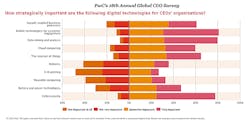One thing is clear to us from our experience with manufacturing CEOs: manufacturers need to develop and execute strategies to seize on technological innovations if they want to continue to succeed. Increasingly, manufacturers are leveraging digital technologies, 3D printing (3DP), robotics, and other advances to build better products, operate more efficiently, and communicate more effectively with their customers. If you aren’t taking the technological leap forward, it’s time to get moving – your competitors may already be there.
According to PwC’s 18thAnnual Global CEO Survey, global CEOs of industrial manufacturing firms are recognizing the significance of 3DP, robotics, and other technological advances. They regard using mobile technologies for engaging customers (73%), cybersecurity (72%), and data mining and analysis (70%) as strategically important. Indeed, among those CEOs who plan to form new alliances or joint ventures this year, 60% plan to do so in order to gain access to new technologies.
For long-time industrial manufacturers, seizing the latest digital innovation opportunities might not be intuitive. After all, industrial manufacturing is not the technology sector. However, this makes it even more crucial to analyze your businesses and see how digital technology (in all of its different forms) might benefit your companies.
In that paper, we discussed data from the PwC and Zpryme 2014 Disruptive Manufacturing Innovations Survey, in which 145 U.S. manufacturers reported what they are (or are not) doing regarding IoT and their plans for building more sophisticated, data-driven businesses. Consider these findings:
- 35% currently collect and use data generated by smart devices to enhance manufacturing/operating processes, and an additional 17% plan to do so in the next three years;
- 38% currently embed sensors in products that enable end-users/customers to collect sensor-generated data, with an additional 31% planning to do so in the future; and
- 34% believe it is “extremely critical” for U.S. manufacturers to adopt an IOT strategy.
Many manufacturers are leveraging more data in their operations and responding to customer needs by embedding intelligence into their products to increase functionality. These businesses are connecting products to the IoT to track product performance over lifecycles to satisfy customers’ expectations for smart products and to increase their product-related services. Still, the percentage of manufacturers engaging with the IoT is less than half. So if you’re not in the minority who are doing so, ask yourself if you’re falling behind the curve and letting those who are engaging the IoT gain a competitive edge.
Another area to look at closely is 3DP. According to the Innovations Survey, two-thirds are already adopting 3DP to some extent. And, we estimate that the global 3D printer market will reach $6 billion by 2017 (up from $2.2 billion in 2012). While 3DP thus far has been for low-volume, specialized purposes, we see a future where companies embrace it on an industrial scale for high-volume manufacturing. Have you asked yourself whether you might benefit from 3DP? Should it be part of your strategy?
Are You Ready for Cyber Threats?
Of course, advancements in business are not without their challenges and technological innovation is no exception. For example, with 3DP comes increased cyber threats to your trade secrets. Generally, manufacturers store their trade secrets in a diffuse manner. Some are outlined in product-specification documents or CAD drawings, while others are included in equipment configurations. And many are simply stored in the heads of experienced engineers and managers. Historically, thieves have had to collect trade secrets from multiple sources to divine a company’s secret sauce.
However, as manufacturers adopt 3DP, their trade secrets will increasingly be housed and concentrated in digital files that, like any other digital document, can be hacked. This is because 3DP requires a manufacturer to encode the 3D printer with explicit instructions on how to design the product, including which materials to use and when and how to use them. Manufacturers using 3DP must get serious about cybersecurity.
The desire to implement or expand the use of technology will lead to the need for new skills. Many companies are currently facing a skills gap when trying to fill new or open positions. The increasing role of technology should only exacerbate this problem. Adopting new technologies requires executives who know how to leverage them strategically and workers who know how to operate those technologies.
In our Q4 2104 Manufacturing Barometer, a survey that captures U.S. manufacturers’ industry outlook, nearly two-thirds of industrial manufacturers (64%) have a skill gap to fill over the next 12-24 months to meet their business objectives. Over the past year, 64% of all U.S. industrial manufacturers reported having open positions that their companies were unable to fill with experienced or skilled employees.
Similarly, in the Global CEO survey, 74% of industrial manufacturing leaders were worried about the shortage of skills. To try to fill the gap, 71% were actively searching for talent in different countries, industries or demographic segments.
Notably, the skills gap appears to be prompting additional hiring. Of the 64% who identified having a skills-gap challenge, 66% were planning new hires over the next 12 months (which should add 1.3% to their overall composite workforce). This is also in keeping with a healthier corporate outlook: 81% of the global, industrial manufacturing CEOs were confident of generating higher revenues in the coming year, and 92% were confident of doing so within the next three years.
As with many corporate initiatives, the move to capitalize on digital technology and other innovation is led from the top. Rapid technological innovations targeted to, or adaptable for, industrial manufacturing will be increasingly available. It’s up to manufacturing CEOs to put into place strategies that seize technological innovation opportunities to help companies do business better—and grab customers from competitors that don’t.





